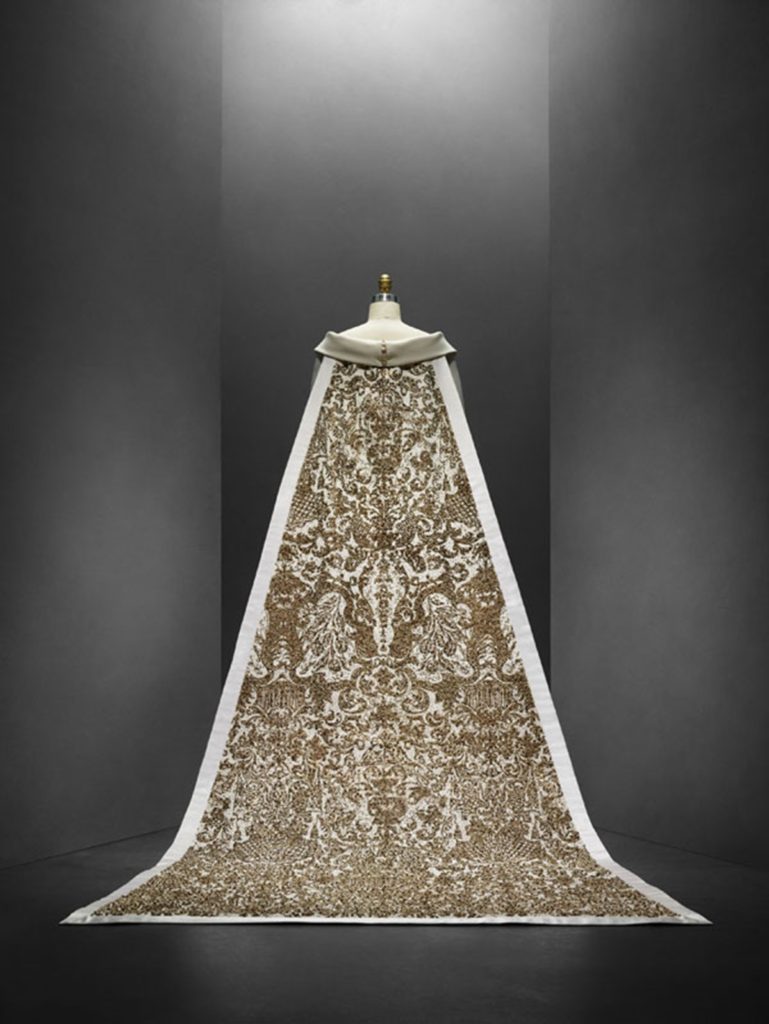It was a hot Sunday afternoon on a three-day holiday weekend, and I decided to visit the Metropolitan Museum* to see Manus x Machina, the costume exhibition that occupies the Lehman wing. It was a revelation on many levels.
 First, the exhibition is, as most commentary has said, a well-thought out execution of a very worthy theme. It certainly lives up to its description of “explor[ing] how fashion designers are reconciling the handmade and the machine-made in the creation of haute couture and avant-garde ready-to-wear.” Some outfits are stunningly beautiful; others are stunning for what they accomplish technologically, although one would be hard-put to wear some of them (I know, that’s the the point). Many, as critics have pointed out, function more as sculpture than as costume. But one thing is clear: fashion now delightly mixes hand and machine work, as the centerpiece of the show, Karl Lagerfield’s wedding dress (at left) so beautifully illustrates.
First, the exhibition is, as most commentary has said, a well-thought out execution of a very worthy theme. It certainly lives up to its description of “explor[ing] how fashion designers are reconciling the handmade and the machine-made in the creation of haute couture and avant-garde ready-to-wear.” Some outfits are stunningly beautiful; others are stunning for what they accomplish technologically, although one would be hard-put to wear some of them (I know, that’s the the point). Many, as critics have pointed out, function more as sculpture than as costume. But one thing is clear: fashion now delightly mixes hand and machine work, as the centerpiece of the show, Karl Lagerfield’s wedding dress (at left) so beautifully illustrates.
I’m not so sure I liked the organization–which is by “metier,” or trade (embroidery, pleating, leather work, lace, featherwork and flowers, plus a section on the foundations for these designs), which led to some jarring juxtapositions–but I understand that there’s no other way for this kind of show. Chronology certainly would not work. And some juxtapositions of the old and new were wonderful.
 Unlike others, I disliked the installation–especially the eerie music (by Brian Eno), which I found too pervasive and clearly intended to create a church-like religion of fashion. Too much reverence for my taste. It’s also a 180 from what so many museums are doing–trying to cut back the reverence for art and make it “fun.” I think that I’d prefer chatter to this music, just as at other exhibitions (though some voices here were louder than usual for a museum).
Unlike others, I disliked the installation–especially the eerie music (by Brian Eno), which I found too pervasive and clearly intended to create a church-like religion of fashion. Too much reverence for my taste. It’s also a 180 from what so many museums are doing–trying to cut back the reverence for art and make it “fun.” I think that I’d prefer chatter to this music, just as at other exhibitions (though some voices here were louder than usual for a museum).
I spent extra time in the exhibition to people-watch. I have to credit the Met here because the crowd was so eclectic. There were, as always with fashion show, a lot of women, both old and young, in pairs and groups. There were a lot of couples. There were a lot of people who were intensely interested in fashion, making comments on every piece as if they were, oh, Joan Rivers.
More interestingly, there seemed to be a lot of people, and more men than usual, who were studying the technology–making remarks about 3-D printing (which many costumes employed), about laser cutwork and so on. Of course, the exhibit was packed with people using their cell phones to capture designs, but there were also many individuals–men and women–with large SLR cameras taking pictures of specific designs, including details (above right), and labels.
It’s not a leap to think that this show will inspire new fashion designers or, better yet, new designers in other areas.
When I arrived back in the Great Hall, I found the museum to be just as crowded there as in the costume show. I walked through the Medieval hall and the antiquities galleries and peeked into some European paintings galleries. All jammed.
On my way home, I stopped at the Met Breuer. Alas, it was fairly empty–certainly by comparison. Makes me wonder how Diane Arbus, which certainly has been getting press, will fare there.
Photo Credits: Courtesy of the Met (top); detail of a dress by Noa Raviv (bottom), taken by me.Â
*I consult to a foundation that supports the Met.
